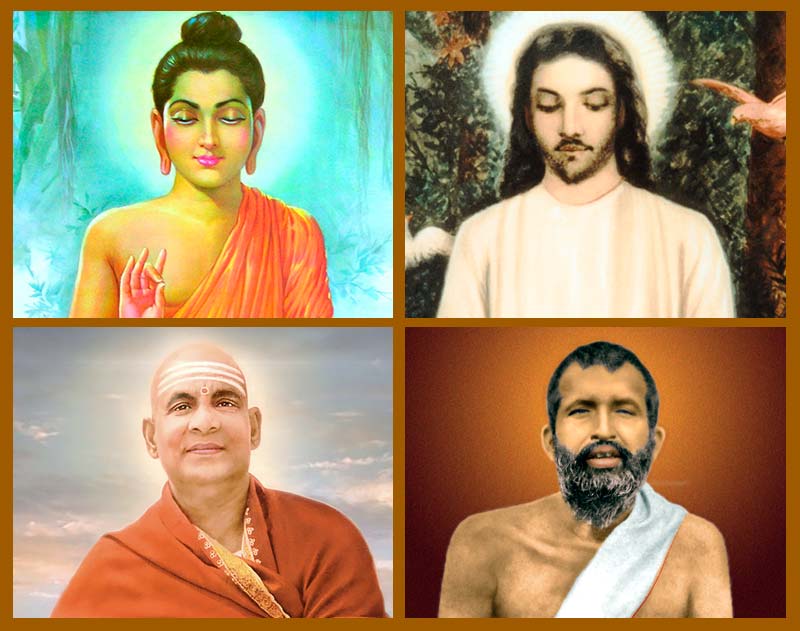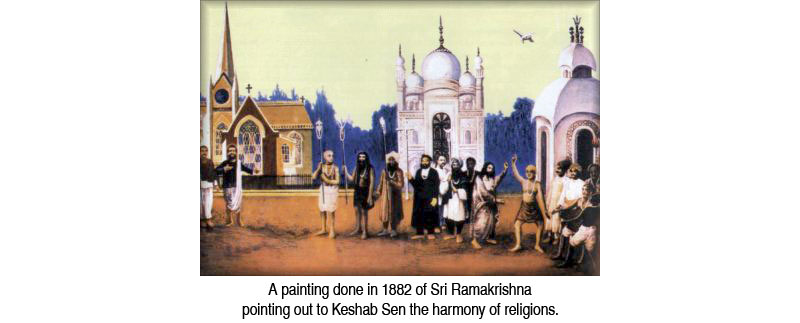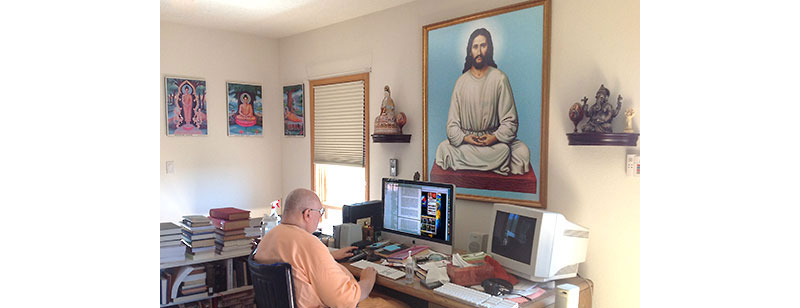
In response to a past blog posting about the reality of Jesus in the experience of India’s great yogis, we received a most heartening letter from India. I want to share parts of it with you and my reflections on it for I feel it presents the most authentic perspective on these matters.
“I agree with the contents of the blog that the truth of Christ’s coming should not be doubted. In fact, if someone whom I can accept as a good Christian were merely to tell me Christ is for real, I would believe him. I would tell him that my mother, a practising Hindu, taught me that long ago, and had read out His parables to me in my childhood!! Christ is as real to me as my mother.”

More than one person has told me that they never met anyone who really understood Jesus until they went to India. My doctor told me that the only meaningful discourse he ever heard about Jesus was given by a sadhu in South India one Christmas.
One of my most valued acquaintances made in India was a French lady who told me: “You will be surprised to learn why I am in India. My local Catholic priest sent me. He told me: ‘You will never understand the Gospel of Saint John if you do not go to India and study the religion there.’” She did so, became a disciple of Swami (Papa) Ramdas, and later permanently moved to India and became a resident of Sivanandashram in Rishikesh.
It is my conviction that intelligent belief in and understanding of Jesus is impossible without the perspective of Sanatana Dharma. (In fact, I don’t think any valid religion can be comprehended without that perspective.)
“I already believe. But I am not alone. It is a natural way for most of my fellow-Hindus. Sri Ramakrishna and Swami Sivananda were representative Hindus who gave all faiths their due. Though they were Hindu spiritual giants, it is not because of them that the ordinary Indian people are magnanimous in religious belief.
The Sanatana Dharma (even in the form of Hinduism) is beginning-less and endless. It is a way of life, a way of thinking for the Hindus, of which the above-mentioned Sages were spokespersons. Everyone has freedom of faith and worship in India, that’s its ageless tradition of open-ness and religious egalitarianism.
On the reality of Christ’s advent, therefore, and His ascension, there can be no doubt.”
This is the unique glory of India–only there have people’s minds and hearts been fully opened to Reality. I often comment to people that it is all very well for people of various religious backgrounds to say that all religions are true and lead to the same goal, but only Indian religion teaches that as a real principle.
Absolutely those great souls mentioned are representative of Sanatana Dharma, not unusual or unique. I know, because I received my faith in Jesus from India. In university I had come to completely disbelieve in Christianity and therefore in Jesus. But when I read the Bhagavad Gita and Paramhansa Yogananda’s Autobiography of a Yogi I gained real faith–in Jesus, but not in the religion that betrays him in his name. The more I understood Dharma, the more I understood Jesus, and the less regard I had for Churchianity.
“What would interest me is to know whether you and the followers/monks of OCOY would also keep pictures of Sri Ram/Siva in their rooms like Sri Ramakrishna or sing the name of the Hindu god(s) like Sri Sivananda in their “Light of the Spirit” monasteries, in line with the Hindu sages you have cited. And it is my fervent hope that they would.”

I really had to smile when I read this, because I knew exactly what our friend was wanting to know. Quite some time back when I was in Delhi someone asked me to go with him to visit some “open-minded” and “ecumenical” Christian monks who were “friendly” to Hindu Dharma. I had my doubts, but I went–and got my doubts confirmed. The abbot was very gracious and showed us around, commenting in the chapel that quite a few Hindus sometimes came to their church services and appreciated them. Then we went to the monastery’s common room where all the monks were in conversations with one another, and the abbot and the senior officers of the monastery began talking with me. Again, the abbot remarked about how “open” Hindus were to their Christian worship.
So I replied: “But tell me, Father, what would you do if one of those Hindus said to you: ‘Father, I have worshipped your Christ; will you now come and worship my Krishna?’ What would you do? Would you go worship Krishna?” His response? NONE. Literally he acted like I had never spoken those words. So I asked the same thing. No reply. A third time I asked, and he just turned to one of the monks and began a conversation as if I were not even there and had not spoken a word. My friend was shocked at this revelation of the hypocrisy of the “good fathers.”
There is indeed in our office a picture of Shiva (Umapati Shankar) and Sri Rama (Ayodhya Pati Ram). At first in writing this I listed every holy image in our office, but the list was much too long to impose on you, so I encapsulate it in this way: In our office there are twelve Christian images, nine Buddhist images, and eighteen Hindu images. Yet they are all images of The One Reality and we reverence them all. Such sacred depictions can be found throughout our monastery, and outside as well, among them many photographs of saints–Hindu, Buddhist, and Christian. Yet, as I say, to us it is all ONE.
I would like to mention here that we have daily satsang in the late afternoon at which we always have three readings from spiritual texts. Right now we are going through: Man’s Eternal Quest, a book of talks by Paramhansa Yogananda, The Christian Gnosis, by Charles W. Leadbeater the renowned Theosophist and founder of the Liberal Catholic Church, and Philosophy of Gorakhnath, by Akshay Kumar Banerjea. I want you to understand from their nature that our approach is not a mere tinge of the East.
It has been our custom for years to attend and participate in (not just observe) Buddhist and Hindu temple worship. Of course we will sing the Names of God in kirtan. There is only one God, and He is all His “many faces.” Any religion that makes people sectarian is a false and destructive religion.
“And further that the ‘LOTS’ Church has unequivocally and publicly repudiated the principle and practice of proselytisation. In fact, an assertion/clarification prominently in the web-site to the above effect would go a long way to confirm the ‘Sanatana Dharma’ aspect of the monastery and the ethical integrity of the ‘Original Christianity’ that is professed, and set the LOTS Church apart from the ‘Churchianity’, besides drawing more and more readers to your excellent blogs.”
This is most important. Each person’s religion is a matter of his swadharma as expounded in the Gita. And swadharma is determined by samskara and karma. No one should ever try to persuade someone to adopt any religion. Each person must decide this for himself. Nor should anyone try to dissuade a person from following a path he feels drawn to. After all, see how many paths Sri Ramakrishna followed and discovered that each one led to Brahman.
There is really only one ultimate religion: Brahmajnana or Atmajnana (knowledge of God or knowledge of the Self, however a person prefers to view it). Without jnana, religion almost always becomes superstition and distraction. Yet if that is what a person likes he should be free to follow it. After all, he has eternity to learn for himself the way to God. This is part of the divine plan.
Do you want to know if we believe that Jesus is the only way or the best way? NEVER. God is the only and the best way. How we reach God is part of our personal evolution. Great world-teachers like Krishna, Buddha and Jesus only show the way to God. As Buddha said, they are a finger pointing to the moon. It is good to learn and apply the wisdom of great Masters, but God must be the focus of our search, for Patanjali says: “He is Guru even of the ancients.”
Why then are we followers of Jesus? (The word “Christian” has been so ruined, just as the Nazis spoiled people’s impression of the Swastika, that I don’t much like using it.) It is not my place to answer for others, so I will say this:
- I follow Jesus because I believe he was a teacher of Sanatana Dharma alone and that his teachings cannot be understood apart from Dharma.
- What is distinct about Jesus is the fact that he presented spiritual life in terms that Occidentals could relate to and that were in accord with their psychology. He was bringing the eternal wisdom of India to the West that simply had no background to help them in relating to it. Therefore he translated those truths into forms they could comprehend. (The Trinity is a prime example. Instead of Brahman, Ishwara and Shakti he used the terms Father, Son and Holy Spirit–not as perfect as the Sanskrit, but still conveying the concepts.)
- Knowing that the traditional Samskaras of Indian religion were very important as a foundation and fostering of spiritual consciousness, he created the Sacraments to accomplish the necessary openings and empowerments in forms the West could relate to and benefit from, even if their philosophical understanding was not perfect. This is the living heritage of Jesus still remaining in the world, however poorly it has been understood through the centuries. For those outside the spiritual environment of India these rites have an inestimable value in imparting spiritual stability and perseverance. I have written about this at length in The Yoga of the Sacraments. Again, no one thing is absolutely necessary in spiritual life except the aspiration to liberation (moksha). As Sri Ma Anandamayi often said: “The desire for God is the way to God,” and “There are many ways to the One Way.”
“I may kindly be pardoned if I have written in ignorance but I felt like telling you what I have and so I out-ed with it!”
And I hope you will forgive my long response! But I wanted to leave no doubts as to our position on these things. Christian bigots and Hindu bigots will both hate what I have written, but hate is their favorite pastime, and that is their choice. We, dear friend, can join hands and hearts and walk together along the path from the unreal to the Real, from darkness to the Light, and from death to Immortality.
Random Gems from the Light of the Spirit Blog and OCOY.org:
- 7 Ways to Purify the Mind
- How to Develop Intuition by Paramhansa Yogananda
- Obstacles in Meditation and How to Overcome Them







